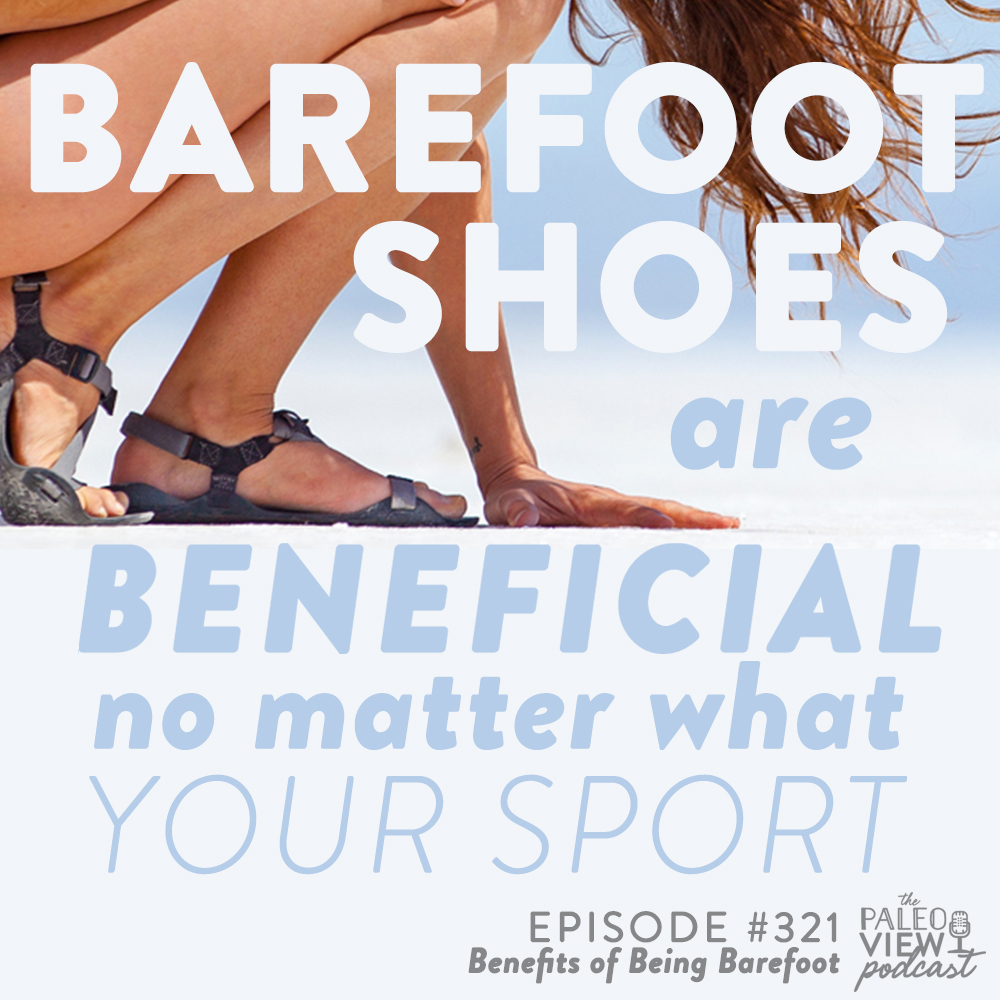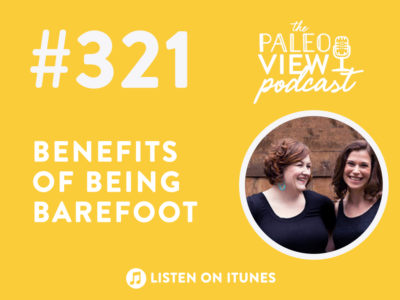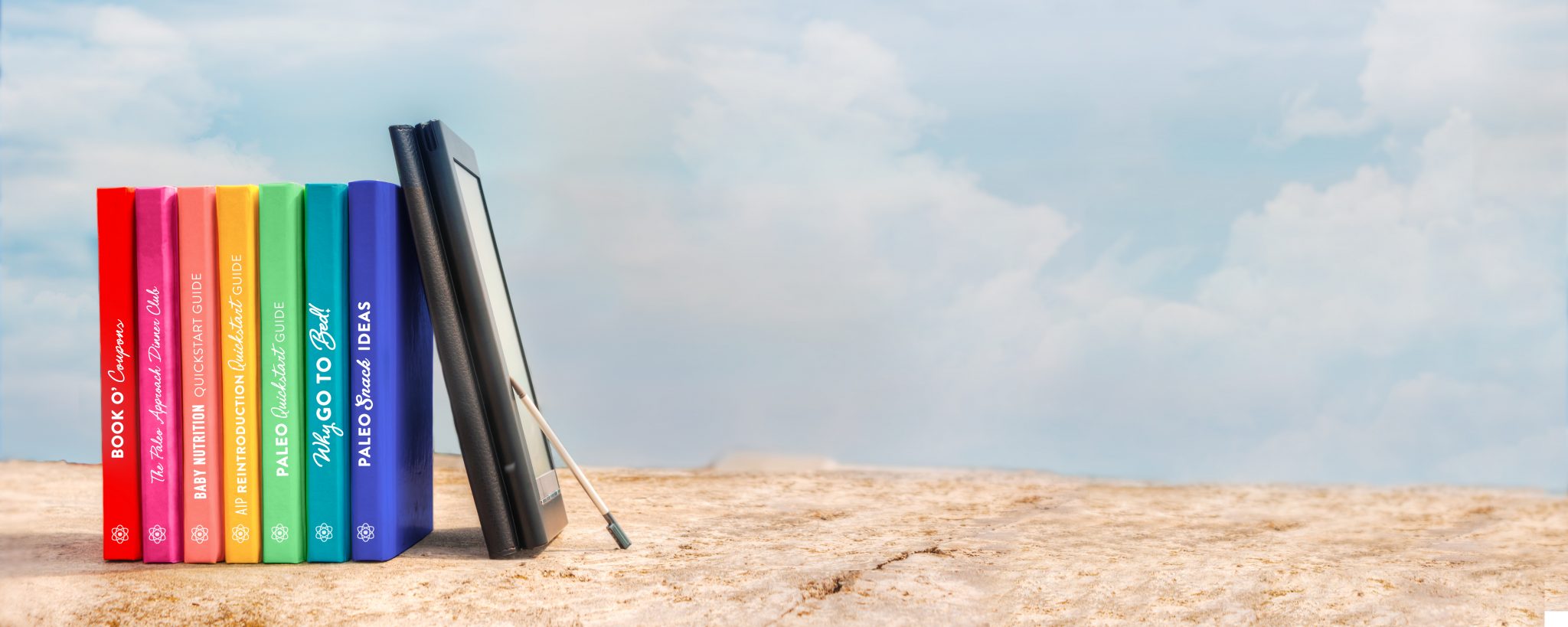In this episode, Stacy and Sarah discuss the surprising number of benefits of wearing minimalist (aka barefoot) shoes! From relieving back pain to helping prevent injury, find out the science behind why minimalist shoes work, the best way to transition into minimalist shoes, as well as Stacy and Sarah’s favorites!
Click here to listen in iTunes
or download and listen by clicking the PodBean Player below
![]()
If you enjoy the show, please review it in iTunes!
The Paleo View (TPV), Episode 321: Benefits of Being Barefoot
-
- (0:00) Intro
- (0:40) News and Views
- How low can they go – who has the lower voice?!
- Get excited, Sarah is working on a new microbiome-focused book! In writing the book, Sarah has discovered some major knowledge-bombs that will rock your world!
- (6:07) Introducing today’s topic: the benefits of being barefoot and minimalist shoes
- Stacy and Sarah both started wearing minimalist shoes when they went paleo.
- Stacy loves Xero Shoes, especially for Stand Up Paddle-boarding (aka SUPing). They’ve helped her back feel better!
- In fact, today’s episode is sponsored by Xero Shoes!
- Check out Xero Shoes here: xeroshoes.com/thepaleoview
- Xero Shoes have been a game changer for Sarah when using her treadmill desk.
- If you want a Pokemon Go friend code, message Sarah on Instagram…
- Sarah bought her first pair of Xero Shoes – Z-Trek sandals – at the Ancestral Health Symposium!
- The whole idea behind minimalist shoes is that your foot can move as naturally as if it’s barefoot, but you have protection from sharp objects, dirt, etc.
-
- Sarah is such a fan, she owns 4 pairs of Xero Shoes! And Stacy has 2 pairs of Xero Shoes!
- (19:36) The science behind why barefoot shoes are good for you
- ‘Barefoot shoe’ and ‘minimalist shoe’ can be used interchangeably
- Science shows that the more material we have on our feet, the more it changes the biomechanics of our foot and leg motion in what appears to be a negative way.
- This means most standard shoes interfere with our biomechanics and can lead to greater chance of injury.
- Barefoot shoe studies are showing some exciting results:
- Less stress on the knee joints
- When you wear barefoot shoes, it carries over and can positively impact how you move when wearing standard shoes
- Because barefoot shoes allow you to feel the ground under your feet, many more smaller muscles in your feet and ankles are activated, which strengthens your feet, lowering chance of injuries like ankle sprains
- Training in barefoot shoes can increase muscle volume in the legs and feet and can decrease the need for orthotics
- There is an increased risk of injury when transitioning to minimalist shoes because your feet are learning, adapting, and strengthening. This period can last up to 6 months.
- When switching to minimalist shoes, runners will naturally correct their stride (landing on the ball of their foot first, versus landing on their heels).
- Long term, people who are experienced in running in minimalist shoes have a lower injury rate. People who run in standard shoes have a 3.41% higher chance of injury than those wearing standard shoes.
- Current science-supported benefits of minimalist footwear:
- reduced risk of knee injury
- reduced risk of injuring other joints and muscles
- improved strength and flexibility of our legs and feet
- improved overall biomechanics of our lower body
- reduced chronic exertional compartment syndrome
- increased muscle volume in our legs and feet
- (33:06) Transitioning to barefoot shoes
- Stacy was nervous about switching over because of past ankle injuries, but they actually improved her ankle mobility. They were so comfortable it was barely a transition.
- Stacy wears barefoot shoes to work out and in her free time, but hasn’t quite made the leap to barefoot shoes for her corporate life. It’s mostly an aesthetic thing. But minimalist shoes have encouraged her to ditch the heels and wedges and switch to ballet flats at work.
- But there are minimalist options for corporate wear.
- And just remember – do the best you can as often as you can!
- Try wearing regular shoes to work and barefoot shoes the rest of the time.
- When purchasing barefoot shoes, consider the following:
- What activity are you doing most that would benefit most from barefoot shoes?
- Shock absorption, posture, etc.
- It’s okay to take time to transition to barefoot shoes. When Sarah first started wearing wore minimalist shoes, the bottom of her feet hurt because she was using muscles she hadn’t used. Over 6 months of transitioning, whenever her feet hurt, Sarah would switch back to standard shoes.
- If you’re concerned about injury during the transition, work with a running coach!
- If you’re heavier, be aware that the risk of injury when transitioning to minimalist shoes is higher.
- Steven from Xero Shoes recommends doing what Sarah intuitively did – wear your minimalist shoes until they start to hurt and then switch back to your standard shoes. You’re using and strengthening new muscles so you need to give your feet recovery time!
- (48:35) One study gave the following recommendation for runners transitioning to minimalist shoes, though it didn’t give a firm timeframe.
- For the first week, use minimalist shoes during lower key movement like walking, housework, shopping (not during training).
- Then, introduce your minimalist shoes to your training routine, but reduce training volume. Start by using your minimalist shoes for 5% of your run and your standard shoes for the 95%.
- Gradually increase the amount that you use your minimalist shoes during training.
- Overall, Sarah thinks it’s a solid recommendation and is consistent with the idea that if your feet hurt or if you get blisters it’s not because you need to toughen up your feet or do more, it’s because your foot is relearning how to work! Rest and recovery are an important part of the process.
- This paper also recommends a variety of other exercises to build foot strength and mobility. They’re probably exercises you’re already doing in Crossfit (lacrosse ball, foam rolling, etc).
- (54:33) Barefoot shoes for walking and everyday activities
- Most of the studies are done with barefoot runners, but there are a few studies that have been done on walkers and they show similar benefits: better biomechanics, posture, mobility, strength, muscle size.
- Walking more in barefoot shoes can improve your running.
- There isn’t injury data for those walking in barefoot shoes.
- The bottom line: barefoot shoes are beneficial no matter what your sport!
- (56:55) Wrap up and recommendations
- Sarah has the Xero Shoes Z-Trek sandals, the new Jessie sandals (with the loop around the toe), the Prio Running Shoes, and the Daylite Hiker (great for winter!). She loves them all!
- Xero Shoes sells replacements for all the shoe pieces – buckles, hooks, etc – so if you’re rough on your shoes, they’ve got you covered. And the soles have a 5,000 mile warranty on them!! Amazing!
- Stacy has the Jessie sandals and has her eye on the Lena shoes, which would be a great option for work! Stacy wears the Cloud sandals for SUPing.
- Matt has the Prio Men’s Running Shoes, which he loves.
- Get your questions in! We want to hear from you! And there’s no end to questions we can answer and topics we can address!
- Engage on social media! That’s how we get feedback!
- Thank you for listening
Relevant post










